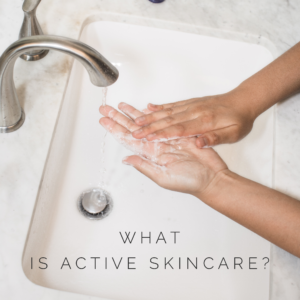What Are Active Ingredients in Skincare Products?
Active ingredients are substances in skincare products that can make actual changes to your skin, helping to alleviate certain skin complaints. These are ingredients that work on your skin at a cellular level.
Now, a good skincare product will usually contain at least one ‘active’ ingredient. However, what tends to vary wildly is the amount of said ingredient in different products. A product needs a generous amount of an ‘active’ ingredient to be effective.
On the other hand, not-so-good skincare products will often just be a cream-based emollient that will sit on the surface of your skin and not go much further than the epidermis. Which is fine – if that’s all you need it to do.
However, deeper down in the dermis tissue, THAT’S where the magic happens!
Here are a few examples of common active ingredients found in skincare products:
- Alpha-hydroxy acids: Think glycolic acid, lactic acid, and mandelic acids. These ingredients encourage exfoliation and result in smooth, soft, glowing skin.
- Beta-hydroxy acids: These include salicylic acid and benzoyl peroxide; both of which are good for refining large pores and controlling breakout activity. Adult acne anyone?
- Vitamin C: Also known as L-ascorbic acid, which brightens the skin and has an anti-inflammatory effect.
- Hydroquinone: A chemical compound which lightens and breaks down pigmentation.
- Retinol: The king (or rather queen) of anti-aging. Retinol smooths and firms the skin, unclogs pores, lightens age spots, and refines skin texture. A great all-rounder.
- Peptides: These are amino acids (proteins) that help to give back structure and strength to your skin cells, which diminish with age.
- Hyaluronic acid: A hugely hydrating ingredient that holds and retains moisture. Great for rehydrating the skin.
Why Do We Need Active Skincare?
In short, to make notable changes to your skin: Think pigmentation, lines and wrinkles, rough, dull skin, etc.
As mentioned above, the concentration level of an active ingredient is important. As a general rule, the first item on the ingredients list is usually the strongest component in the product (just like in food), while the last one listed comprises the least amount.
So, if you buy a beautiful anti-aging cream and retinol is at the bottom of the ingredient list, it probably won’t have much of a long-term effect and is unlikely to make much noticeable difference.
How Deep Will Each Product Go?
This largely depends on the percentage of the active ingredient, its pH, and its stability. This is where research-based products come out on top, as they are tried and tested to ensure their efficacy. For genuine, confidence-boosting, changes, we need our active products to go deep, past the epidermis.
I hope this post has helped you understand the fundamentals of active ingredients, and why you need them in your skincare routines. What’s important to remember is that these products can lead to undesirable side effects, so they should be used under (professional?) guidance and whilst following instructions that can be tailored to your specific, skin needs.
For more details on what happens when you actually do use active ingredients, check out my other article The Reality of Using Active Products here.
If you’d like some help with your skincare routine and would like to learn exactly what you need and should be using then you can book in for a skin analysis and consultation here.
Best Wishes,
Louise, The Skin Nurse

